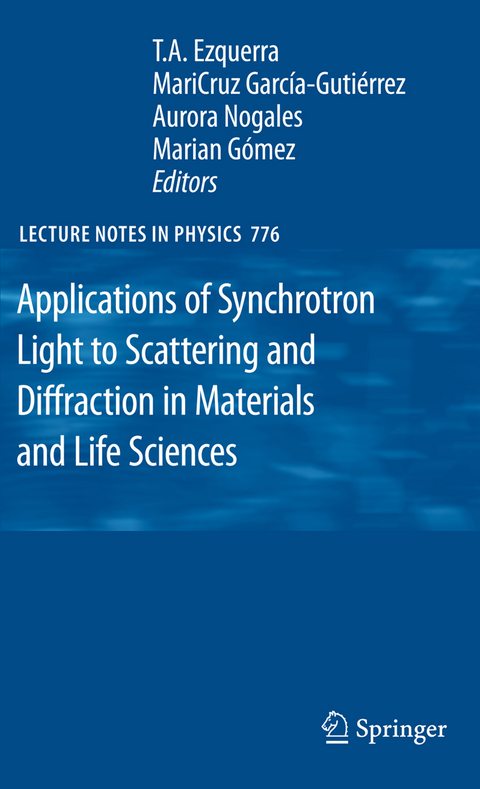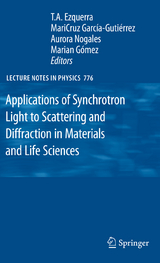Applications of Synchrotron Light to Scattering and Diffraction in Materials and Life Sciences
Springer Berlin (Verlag)
978-3-540-95967-0 (ISBN)
In a ?rst approximation, certainly rough, one can de?ne as non-crystalline materials those which are neither single-crystals nor poly-crystals. Within this category, we canincludedisorderedsolids,softcondensed matter,andlivesystemsamong others. Contrary to crystals, non-crystalline materials have in common that their intrinsic structures cannot be exclusively described by a discrete and periodical function but by a continuous function with short range of order. Structurally these systems have in common the relevance of length scales between those de?ned by the atomic and the macroscopic scale. In a simple ?uid, for example, mobile molecules may freely exchange their positions, so that their new positions are permutations of their old ones. By contrast, in a complex ?uid large groups of molecules may be interc- nected so that the permutation freedom within the group is lost, while the p- mutation between the groups is possible. In this case, the dominant characteristic length, which may de?ne the properties of the system, is not the molecular size but that of the groups. A central aspect of some non-crystalline materials is that they may self-organize. This is of particular importance for Soft-matter materials. Self-organization is characterized by the spontaneous creation of regular structures at different length scales which may exhibit a certain hierarchy that controls the properties of the system. X-ray scattering and diffraction have been for more than a hundred years an essential technique to characterize the structure of materials. Quite often scattering anddiffractionphenomenaexhibitedbynon-crystallinematerialshavebeenreferred to as non-crystalline diffraction.
Bases of Synchrotron Radiation, Light Sources, and Features of X-Ray Scattering Beamlines.- Scattering of Soft Condensed Matter: From Fundaments to Application.- A Basic Introduction to Grazing Incidence Small-Angle X-Ray Scattering.- Fundaments of Soft Condensed Matter Scattering and Diffraction with Microfocus Techniques.- The Use of Scattering and Spectroscopic Synchrotron Radiation Methods in Materials Science.- Synchrotron Small-Angle X-Ray Scattering Studies of Colloidal Suspensions.- Applications of Synchrotron X-Ray Diffraction to the Study of the Phase Behavior in Liquid Crystalline Polymers.- Structural Analysis of Biological and Technical Nanocomposites by X-Ray Scattering.- Application of Non-crystalline Diffraction with Microfocus to Carbon Fibres.- Simultaneous Calorimetric, Dielectric, and SAXS/WAXS Experiments During Polymer Crystallization.- Discovering New Features of Protein Complexes Structures by Small-Angle X-Ray Scattering.- Protein Shape and Assembly Studied with X-Ray Solution Scattering: Fundaments and Practice.- Diagnosis Applications of Non-Crystalline Diffraction of Collagen Fibres: Breast Cancer and Skin Diseases.- X-Ray Diffraction from Live Muscle Fibres.
| Erscheint lt. Verlag | 15.6.2009 |
|---|---|
| Reihe/Serie | Lecture Notes in Physics |
| Zusatzinfo | XVI, 318 p. 177 illus., 20 illus. in color. |
| Verlagsort | Berlin |
| Sprache | englisch |
| Maße | 155 x 235 mm |
| Gewicht | 728 g |
| Themenwelt | Naturwissenschaften ► Physik / Astronomie ► Mechanik |
| Technik | |
| Schlagworte | Biological Microscopy • Crystal • diffraction • Life Sciences • liquid • non-crystalline materials • Polymer • SAXS/WAXS • Structural Analysis • synchrotron • Synchrotron radiation • X-ray scattering • x-ray scattering and diffraction |
| ISBN-10 | 3-540-95967-X / 354095967X |
| ISBN-13 | 978-3-540-95967-0 / 9783540959670 |
| Zustand | Neuware |
| Haben Sie eine Frage zum Produkt? |
aus dem Bereich




